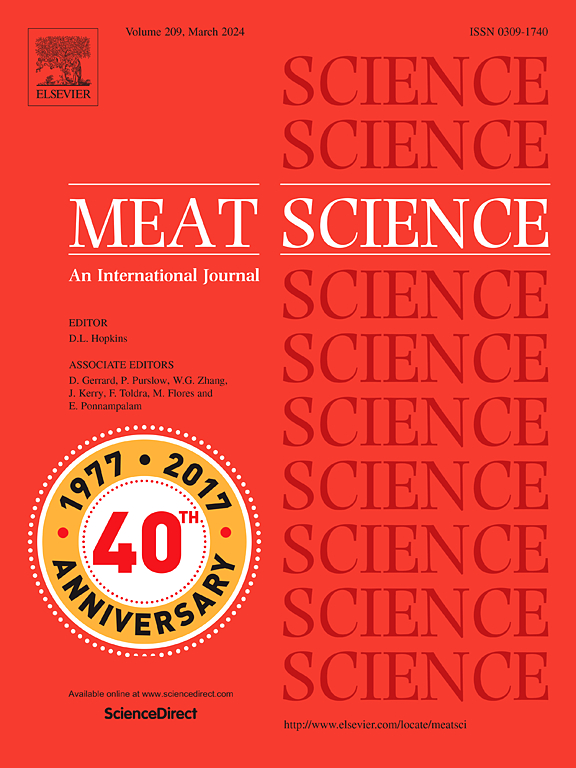In vitro proteolysis mirrors intact muscle maturation in beef carcasses
IF 7.1
1区 农林科学
Q1 Agricultural and Biological Sciences
引用次数: 0
Abstract
An in vitro assay was developed to study protease activity during the maturation of beef postmortem. Myofibrils were purified from the semitendinosus and used as a sentinel for assessing the activity of endogenous proteases in longissimus thoracis et lumborum (LTL) and the extensor carpi radialis (ER) over time postmortem in beef carcasses. Samples were collected from each muscle at 0, 1, 2, 7, and 14 d of aging and snap frozen. Samples were powdered and added to an in vitro proteolysis assay containing buffer and purified myofibrils. Aliquots were collected at 0, 2, 120, 480, and 1440 min of incubation, and intact desmin and troponin-T were quantified. Digestions at 0 and 1 d using either muscle had little desmin degradation during the entire digestion period. In contrast, LTL muscle collected at 2, 7, and 14 d had the greatest proteolytic capacity as indicated by disappearance of intact desmin by 480 and 1440 min incubation. Though degradation ensued using powdered ER muscle, disappearance of intact proteins was limited. Degradation in vitro paralleled that observed in intact muscle. Addition of ethylene glycol tetra-acetic acid (EGTA), a cysteine protease inhibitor, and calpastatin inhibited proteolysis and suggest proteolytic activity observed in muscles and detected in our proteolysis assays is due to an active calpain protease. Collectively, our data show an active protease is minimal in bovine muscle until 48 h postmortem in the LTL muscle and suggest an in vitro assay containing purified myofibrils is a potential tool for studying temporal changes in proteolysis during the maturation and tenderization of beef across muscles.
体外蛋白质分解反映了牛肉胴体中完整肌肉的成熟过程。
我们开发了一种体外测定法来研究牛肉死后成熟过程中的蛋白酶活性。从半腱肌中纯化出肌原纤维,并将其作为哨点来评估牛肉胴体胸腰长肌(LTL)和桡侧伸肌(ER)的内源性蛋白酶活性。在牛肉老化 0、1、2、7 和 14 d 时采集每块肌肉的样本并速冻。将样本打成粉末,加入含有缓冲液和纯化肌纤维的体外蛋白水解试验中。在孵育的 0、2、120、480 和 1440 分钟收集等分样品,并对完整的 desmin 和肌钙蛋白-T 进行定量。在整个消化过程中,0 d 和 1 d 时使用任何一种肌肉进行的消化都几乎没有去蛋白降解。相比之下,在 2、7 和 14 d 收集的 LTL 肌肉的蛋白水解能力最强,在 480 和 1440 分钟的孵育过程中,完整的 desmin 消失。虽然ER肌肉粉末会发生降解,但完整蛋白质的消失是有限的。体外降解与在完整肌肉中观察到的降解相同。加入半胱氨酸蛋白酶抑制剂乙二醇四乙酸(EGTA)和钙蛋白酶抑制蛋白水解,这表明在肌肉中观察到的蛋白水解活性以及在我们的蛋白水解试验中检测到的蛋白水解活性是由活性钙蛋白酶引起的。总之,我们的数据表明,在牛死后 48 小时之前,LTL 肌肉中的活性蛋白酶极少,这表明含有纯化肌原纤维的体外测定是研究牛肉肌肉成熟和变嫩过程中蛋白分解时间变化的一种潜在工具。
本文章由计算机程序翻译,如有差异,请以英文原文为准。
求助全文
约1分钟内获得全文
求助全文
来源期刊

Meat Science
工程技术-食品科技
CiteScore
12.60
自引率
9.90%
发文量
282
审稿时长
60 days
期刊介绍:
The aim of Meat Science is to serve as a suitable platform for the dissemination of interdisciplinary and international knowledge on all factors influencing the properties of meat. While the journal primarily focuses on the flesh of mammals, contributions related to poultry will be considered if they enhance the overall understanding of the relationship between muscle nature and meat quality post mortem. Additionally, papers on large birds (e.g., emus, ostriches) as well as wild-captured mammals and crocodiles will be welcomed.
 求助内容:
求助内容: 应助结果提醒方式:
应助结果提醒方式:


